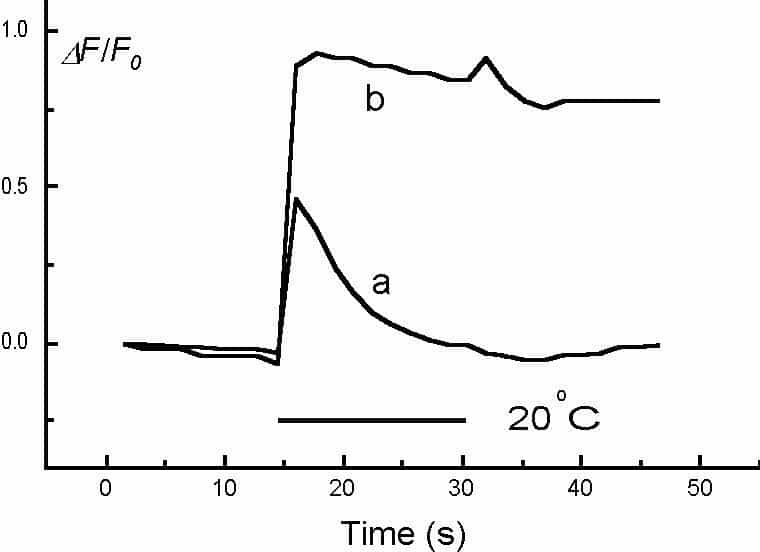At least two types of neurone are involved in cold sensitivity of rodent DRG cultures (Thut et al. 2003; Babes et al. 2004). One group is menthol-sensitive and probably expresses TRPM8, the cold and menthol receptor; the other group, which is menthol-insensitive, has not been yet completely characterised, but it does not appear to express the other cold-activated ion channel, TRPA1. Within this latter group we have identified a new type of cold-sensitive neurone, which responds to fast cooling with a transient increase in [Ca2+]i. Wistar rats were humanely killed. Neurones from DRG levels L1 to S1 were kept in primary culture for up to 3 days (Reid et al. 2002). Temperature steps from 32 to 20°C with a 10 s duration were applied by fast (<100 ms) switching (the fast temperature controlled application system will be demonstrated at the meeting). Calcium Green-1 fluorimetry was used to monitor changes in [Ca2+]i during cooling or application of chemicals. During fast cooling steps some neurones adapted rapidly (a in Fig. 1), while others showed almost no adaptation (b in Fig. 1). While cells showing a sustained response were all menthol-sensitive and thus probably express TRPM8, rapidly adapting cells appear to belong to a novel group of cold-sensitive neurones. Of 2205 imaged neurones, 82 (3.8%) adapted during the cooling step to less than 35% of the initial rise in calcium. The signal depended on extracellular calcium, demonstrating that it was due to Ca2+ entry. Slower cooling ramps ( 0.5°C/s) were less optimal stimuli for activating these rapidly adapting (RA) neurones: only 8 of 27 RA cells responded during such a ramp between 32 and 20°C. RA neurones were insensitive to agonists of known cold-activated ion channels. None of them was stimulated or sensitised by 100 μM menthol: instead, interestingly, they were slightly inhibited by it. They were also insensitive to 200 μM cinnamon aldehyde, a TRPA1 agonist, and to 50 μM icilin, an agonist for both TRPM8 and TRPA1. RA neurones were activated by pH 8 and ruthenium red (10 μM). Capsazepine, an antagonist of both TRPV1 and TRPM8, inhibited RA neurones at 50 μM. Our data provide evidence for the existence of a new type of cold receptor, distinct from the cloned TRPM8 and TRPA1.
University of Bristol (2005) J Physiol 567P, C43
Oral Communications: A novel type of cold-sensitive neurone in rat dorsal root ganglia (DRG) with rapid adaptation to cooling
Babes, Alexandru; Zorzon, Daniel; Reid, Gordon;
1. Dept. of Animal Physiology and Biophysics, Faculty of Biology, University of Bucharest, Bucharest, Romania.
View other abstracts by:
Fig. 1. A rapidly adapting (a) and a non-adapting response (b) to a fast cooling step from 32 to 20 C with a duration of 10 s.
Where applicable, experiments conform with Society ethical requirements.

